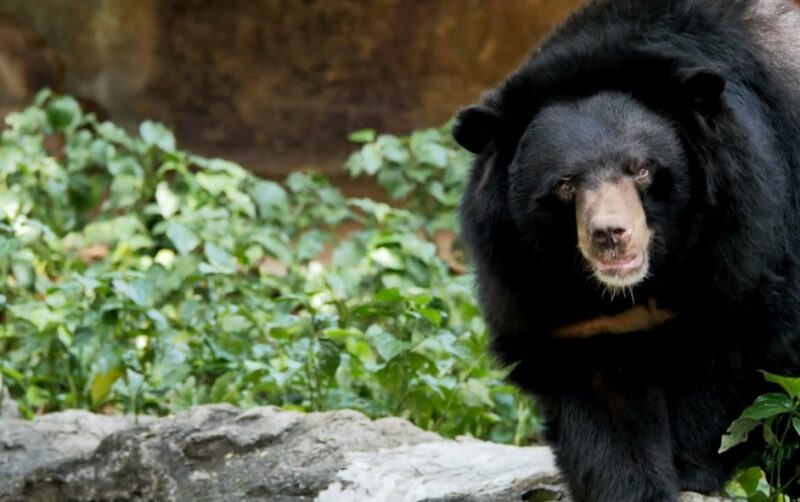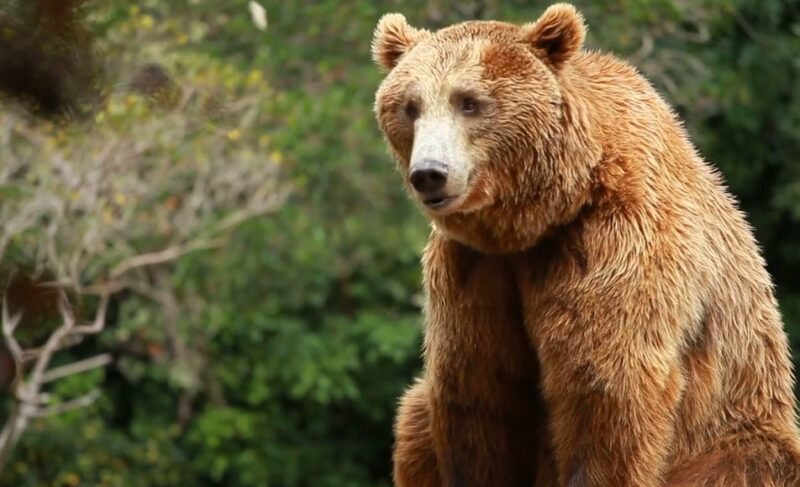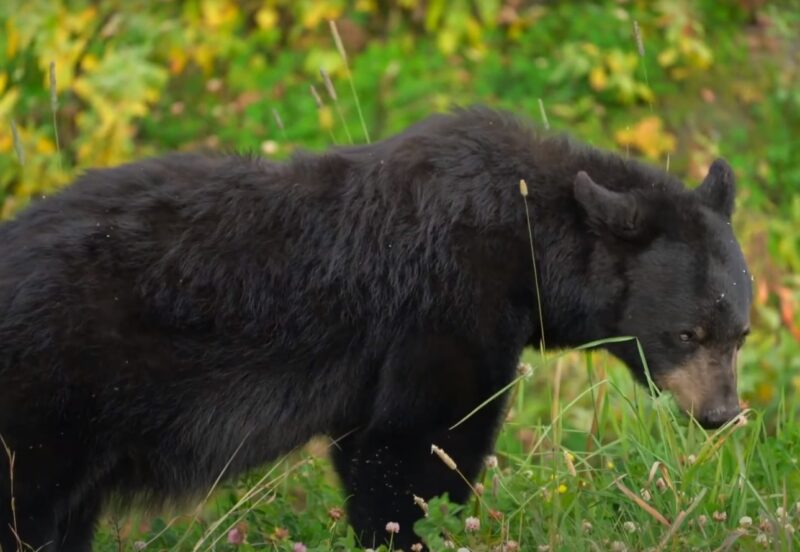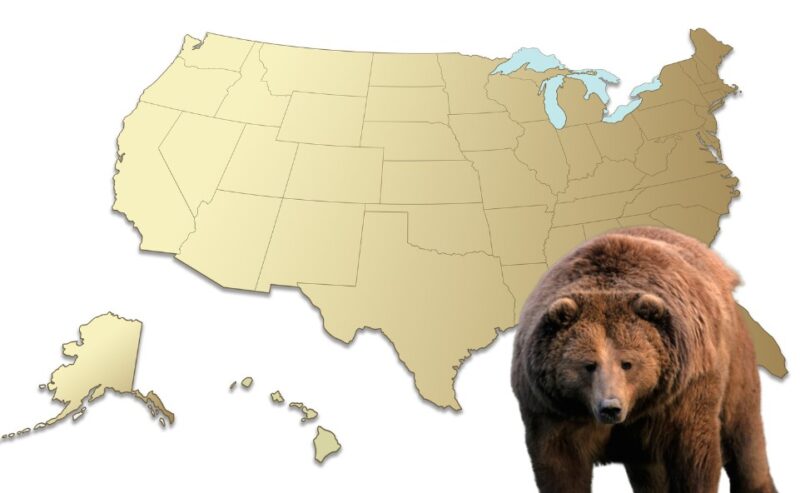The United States is home to a diverse bear population, primarily consisting of three species: the black bear, the brown bear (including grizzlies), and the polar bear.
Black bears are the most widespread, found across many states and habitats.
Brown bears, including the larger sub-species known as grizzlies, are mainly located in Alaska, with some populations in the lower 48 states.
Polar bears, adapted to life in the Arctic, are found along the northern coasts of Alaska.
Estimated Population
Population of Black Bear

The black bear, scientifically known as Ursus americanus, is the most common bear species in North America. Estimates suggest that there are 800,000 to 900,000 black bears across the United States. The distribution of black bears spans from the East Coast to the West Coast, including Alaska, with significant populations in forests, swamps, and wilderness areas.
Distribution and Habitat
Black bears inhabit a wide range of environments across the United States. They are adaptable animals, living in forests, mountainous areas, and swamps. Their habitats are primarily in the eastern United States, along the West Coast, and in parts of Alaska.
The largest populations are found in states like Pennsylvania, New York, North Carolina, and California, where extensive forested areas provide ideal conditions for their survival.
If you are planning to visit Redwood National Park, keep in mind that black bears live around forests, meadows, rivers, and creeks.
Conservation Status
The conservation status of black bears in the United States is generally stable, thanks to effective wildlife management and conservation efforts. In some areas, their numbers have increased to the point where they are considered a success story of wildlife management. However, human-bear conflicts, habitat loss, and road mortality pose ongoing challenges to their populations.
Population of Brown Bear

The brown bear, or Ursus arctos, includes the grizzly bear as a subspecies in North America. The total population of brown bears in the United States is estimated to be around 55,000, with the vast majority residing in Alaska. Smaller populations exist in the lower 48 states, primarily in the Northern Rocky Mountains and parts of the northwestern United States.
Distribution and Habitat
In Alaska, brown bears are distributed widely, from the coastal areas to the interior regions. They thrive in a variety of habitats, including tundra, forests, and mountainous areas. In the lower 48 states, brown bears are primarily found in and around Yellowstone National Park, the Northern Continental Divide (including Glacier National Park), and the Selkirk and Cabinet-Yaak areas near the Canada-US border.
Conservation Status
Brown bears in Alaska are considered stable and are managed through regulated hunting and conservation programs. In the lower 48 states, they are protected under the Endangered Species Act, which has helped their numbers gradually increase. Conservation efforts focus on habitat protection, reducing human-bear conflicts, and connectivity between isolated populations to ensure genetic diversity.
Population of Polar Bear

The polar bear, Ursus maritimus, is the largest bear species and is primarily found within the Arctic Circle. The United States polar bear population is concentrated along the coast of Alaska, particularly in the Beaufort Sea and Chukchi Sea regions. Estimates of the total polar bear population range from 22,000 to 31,000 worldwide, with a significant portion residing in Canadian and Russian territories.
Distribution and Habitat
Polar bears in the United States are found in areas where sea ice is present, as it is crucial for hunting seals, their primary food source. They are highly adapted to life in cold environments, with physical characteristics that allow them to thrive in Arctic conditions. Climate change and the resulting loss of sea ice pose significant threats to their habitat and survival.
Conservation Status
Polar bears are listed as a threatened species under the Endangered Species Act in the United States. The primary threat to their survival is climate change, which affects the availability of sea ice for hunting. Conservation efforts are focused on mitigating climate change impacts, protecting critical habitats, and international cooperation to ensure the survival of this iconic Arctic species.
Are There Endangered Species?
Each species faces its own set of challenges, with some populations under significant threat.
Black Bear – Conservation Success

The black bear is the most common bear species in the United States, with a robust population that has benefited from effective conservation measures. Despite facing habitat loss and human-wildlife conflicts in certain areas, the overall trend for black bears is positive.
Conservation efforts, including habitat protection, regulated hunting, and public education on coexistence, have helped stabilize and even increase black bear populations in many regions. As a result, black bears are not considered endangered at a national level, though some localized populations may still face challenges.
Brown Bear
The brown bear, particularly the grizzly bear subspecies in the lower 48 states, presents a more complex conservation picture. In Alaska, brown bears are abundant, with a stable population that supports regulated hunting.
However, in the contiguous United States, grizzly bears are listed as threatened under the Endangered Species Act. Decades of conservation efforts have led to slow but positive population growth in areas like the Greater Yellowstone Ecosystem and the Northern Continental Divide Ecosystem.
Grizzly Bears in the Lower 48 States
Grizzly bears in the lower 48 states have seen their numbers increase from a few hundred individuals in the 1970s to over 1,800 today, thanks to rigorous conservation efforts.
These efforts include habitat protection, conflict mitigation strategies, and connectivity projects to link isolated populations. Despite these successes, challenges remain, including human-bear conflicts, climate change impacts, and debates over the delisting of grizzlies from the Endangered Species Act.
Polar Bear – Impact of Climate Change
Polar bears are the most vulnerable of the American bear species, directly impacted by climate change through the loss of their sea ice habitat. Classified as threatened under the Endangered Species Act, polar bears face an uncertain future as warming temperatures lead to reduced sea ice, affecting their ability to hunt seals.
Conservation efforts are focused on climate change mitigation, protecting critical habitats, and international cooperation, given the polar bear’s circumpolar range.
Challenges and Conservation Strategies
The primary challenge for polar bear conservation is addressing the root causes of climate change to preserve their sea ice habitat. Strategies include reducing greenhouse gas emissions, protecting key areas of sea ice, and managing human-bear conflicts as bears increasingly come into contact with human settlements due to habitat loss.
FAQs
How many bears are in Russia?
Russia has five types of bears, out of 266 mammal species. There are about 120,000 to 140,000 bears in Russia.
How many bears are in Canada?
Canada has three types of bears: black, grizzly, and polar. The total number of bears in Canada is about 516,000, with black bears being the most common.
Are there bears in New York?
Yes, there are bears in New York, but mostly in the forested regions of upstate New York. The most common bear in New York is the American black bear, with about 6,000 to 8,000 of them.
What is the most aggressive bear?
The most aggressive and dangerous bears are the grizzly and polar bear. Polar bears are the deadliest, but grizzlies attack humans more often.
The Bottom Line
The bear populations in the United States show varying trends: black bears are thriving due to successful conservation efforts, brown bears, including grizzlies, are recovering in certain areas but still face challenges, and polar bears are under threat primarily due to climate change. The future of these species hinges on continued and focused conservation efforts, addressing habitat loss, human-wildlife conflicts, and the impacts of climate change.
